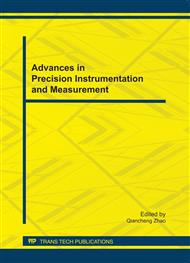[1]
X. Zhang, B. Bureau, P. Lucas, Glasses for Seeing Beyond Visible, Chem. Eur. J. 14(2008), 432-442.
DOI: 10.1002/chem.200700993
Google Scholar
[2]
B. Bureau, C. Boussard-Pledel, P. Lucas, X.H. Zhang, J. Lucas, telluride glass step index fiber for the far Infrared, Molecules 9 (9)(2009), 7398-7411.
DOI: 10.1109/jlt.2010.2087008
Google Scholar
[3]
J.S. Sanghera, F.H. Kung, L.E. Busse, P.C. Pureza, I.D. Aggarwal, Infrared evanescent absorption spectroscopy of toxic chemicals using chalcogenide glass fibers, J. Am. Ceram. Soc. 78 (8) (1995), 2198-2202.
DOI: 10.1111/j.1151-2916.1995.tb08636.x
Google Scholar
[4]
L.E. Busse, J. Moon, J.S. Sanghera, I.D. Aggarwal, Chalcogenide fibers deliver high IR power, Laser World Focus 32(9) (1996), 143-150.
Google Scholar
[5]
A.A. Wilhelm, C. Boussard-Pledel, Q. Coulombier, Development of far-infrared-transmitting te based glasses suitable for carbon dioxide detection and space optics, Adv. Mater. 19(22)(2007), 3796-3800.
DOI: 10.1002/adma.200700823
Google Scholar
[6]
S. Donto, P. Houizot, C. Boussard-Pledel, X.H. Zhang, F. Smektala, J. Lucas, A family of far-infrared-transmitting glasses in the Ga-Ge-Te system for space applications, Adv. Funct. Mater. 16(2006), 1847-1852.
DOI: 10.1002/adfm.200500645
Google Scholar
[7]
S. X. Dai, B. Peng, X. Shen, Elimination of Impurities in Ge-Se-Sb Glasses, Acta Photonica Sinica 37(2008), 1-4.
Google Scholar
[8]
A. Feltz, W. Burckhardt, B. Voight, D. Linke, Optical glasses for IR trans- mittance, J. Non-Cryst. Solids 129(1991), 31-39.
DOI: 10.1016/0022-3093(91)90077-j
Google Scholar
[9]
S. B. Bhanu Prashanth, S. Asokan, A composition dependent thermal behavior of GexSe35-xTe65 glasses, J. Non-Cryst. Solids 355(2009), 1227-1230.
DOI: 10.1016/j.jnoncrysol.2009.05.004
Google Scholar
[10]
T.S. Kavetskyy, A.P. Kovalskiy, V.D. Pamukchieva, O.I. Shpotyuk, IR impurity absorption in Sb2S3–GeS2(Ge2S3) chalcogenide glasses, Infrared Phys. Technol. 41(2000), 41-45.
DOI: 10.1016/s1350-4495(99)00055-9
Google Scholar
[11]
M.F. Churbanov, I.V. Scripachev, G.E. Snopatin, V.S. Shiryaev, V.G. Plotnichenko, High purity glasses based on arsenic chalcogenides, J. Opt. Adv. Mater 3(2001), 341-349.
DOI: 10.1016/j.jnoncrysol.2010.11.057
Google Scholar
[12]
S. X. Dai, J. J. Zhang, C. L. Yu, G. Zhou, G. N. Wang, L. L. Hu, Effect of hydroxyl groups on nonradiative decay of Er3+ : 4I13 / 2-4I15 / 2 transition in zinc tellurite glasses, Materials Letters 59(2005), 2333-2336.
DOI: 10.1016/j.matlet.2005.02.076
Google Scholar
[13]
X. Liu, V. Tikhomirov, A. Jha, Influence of vapor-phase reaction on the reduction of OH- and S-H absorption bands in GeS2-based glasses for infrared optics, J. Mater. Res. 15(2000), 2864-2874.
DOI: 10.1557/jmr.2000.0409
Google Scholar


